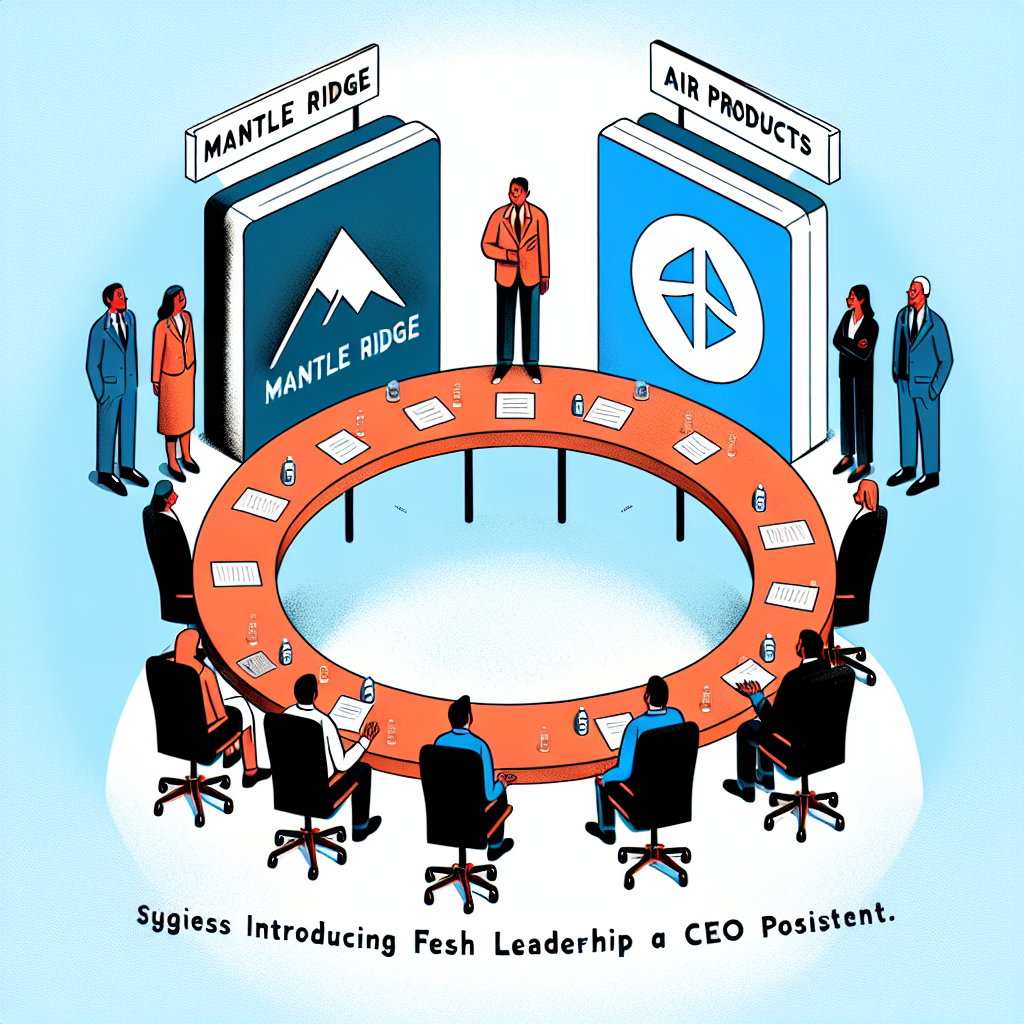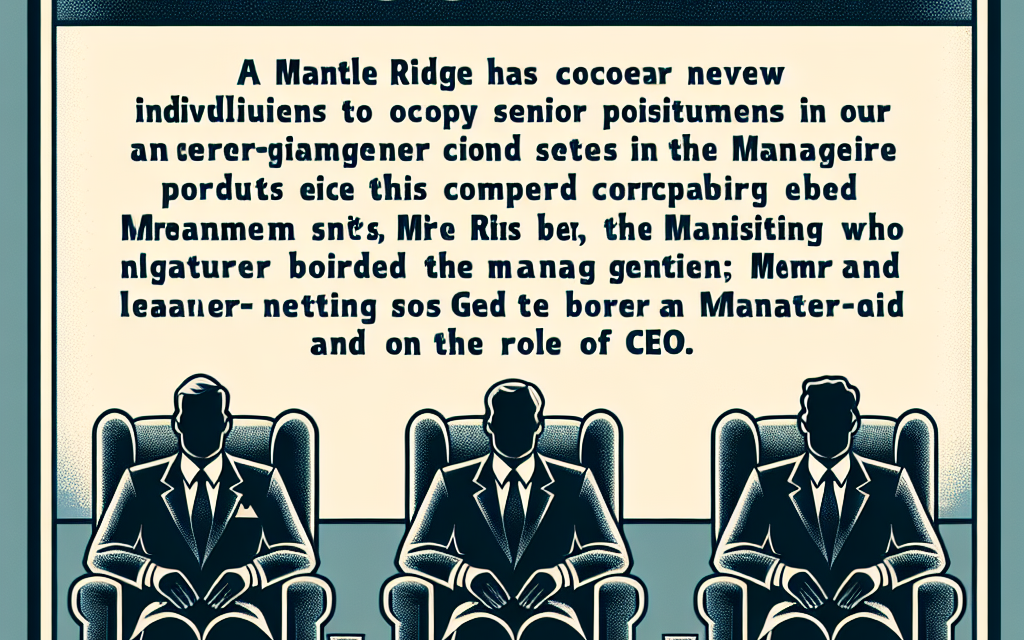“Charting New Horizons: Mantle Ridge Advocates for Transformative Leadership at Air Products.”
Introduction
Mantle Ridge, an activist investment firm known for its strategic interventions in corporate governance, has recently proposed significant leadership changes at Air Products and Chemicals, Inc. The firm has put forward a plan to overhaul the company’s board of directors and appoint a new CEO, aiming to enhance operational efficiency and drive shareholder value. This move underscores Mantle Ridge’s commitment to reshaping Air Products’ strategic direction and optimizing its market performance. The proposal has sparked discussions within the industry, highlighting the ongoing trend of activist investors seeking to influence major corporate decisions to unlock potential growth and profitability.
Impact Of Leadership Changes On Air Products’ Strategic Direction
Mantle Ridge, an activist investment firm known for its strategic interventions in major corporations, has recently proposed significant leadership changes at Air Products, a leading industrial gases company. This move has sparked considerable interest and speculation regarding the potential impact on the company’s strategic direction. The proposal includes the appointment of new board members and a change in the CEO position, a shift that could herald a new era for Air Products.
The rationale behind Mantle Ridge’s proposal is rooted in its belief that fresh leadership could unlock greater value for shareholders and enhance the company’s competitive position in the global market. By advocating for new perspectives at the helm, Mantle Ridge aims to drive strategic initiatives that could potentially lead to increased operational efficiency and innovation. This approach is not uncommon among activist investors, who often seek to influence corporate governance to align with their vision of maximizing shareholder returns.
Transitioning to new leadership can be a complex process, fraught with challenges and opportunities. For Air Products, the proposed changes could lead to a reevaluation of its current strategies and priorities. The company has long been recognized for its focus on sustainability and innovation, particularly in the development of hydrogen as a clean energy source. A shift in leadership might accelerate these initiatives, or conversely, it could result in a strategic pivot towards other emerging opportunities within the industrial gases sector.
Moreover, the introduction of new board members and a CEO could bring about a cultural shift within the organization. Leadership changes often influence corporate culture, affecting everything from decision-making processes to employee morale. It is crucial for Air Products to manage this transition carefully to maintain stability and continuity while embracing new ideas and strategies. The ability to balance these elements will be key to ensuring that the company continues to thrive in a competitive landscape.
In addition to internal dynamics, the proposed leadership changes at Air Products could have broader implications for the industry as a whole. As a major player in the industrial gases market, Air Products’ strategic decisions often set trends and influence competitors. Should the company adopt new strategies under fresh leadership, it could prompt other firms to reassess their own approaches, potentially leading to shifts in industry standards and practices.
Furthermore, the response of stakeholders, including investors, customers, and employees, will play a critical role in shaping the outcome of this leadership transition. Investor confidence is particularly important, as it can impact the company’s stock performance and financial stability. Mantle Ridge’s involvement may reassure some investors, given its track record of successful interventions in other companies. However, others may adopt a wait-and-see approach, monitoring how the proposed changes unfold before making any judgments.
In conclusion, Mantle Ridge’s proposal for new leadership at Air Products represents a significant development with the potential to influence the company’s strategic direction profoundly. While the outcome remains uncertain, the transition offers an opportunity for Air Products to reassess its goals and strategies in light of evolving market conditions and stakeholder expectations. As the situation develops, it will be essential for all parties involved to navigate the complexities of change with foresight and adaptability, ensuring that Air Products continues to lead and innovate in the industrial gases sector.
Analyzing Mantle Ridge’s Influence In Corporate Governance
Mantle Ridge, a prominent activist investment firm, has recently made headlines with its proposal for new leadership at Air Products, a leading industrial gases company. This move has sparked considerable interest and debate within the corporate governance sphere, as it underscores the growing influence of activist investors in shaping the strategic direction of major corporations. Mantle Ridge’s proposal involves not only changes to the board of directors but also the appointment of a new CEO, a bold step that highlights the firm’s commitment to driving significant change.
The rationale behind Mantle Ridge’s proposal is rooted in its belief that Air Products can achieve greater operational efficiency and enhanced shareholder value under new leadership. By advocating for a refreshed board and a new CEO, Mantle Ridge aims to inject fresh perspectives and innovative strategies into the company’s decision-making processes. This approach is not uncommon among activist investors, who often seek to unlock value by challenging the status quo and pushing for transformative changes.
Transitioning to the broader implications of this proposal, it is essential to consider the potential impact on Air Products’ strategic direction. A change in leadership can lead to shifts in corporate priorities, potentially affecting everything from research and development initiatives to market expansion strategies. For instance, a new CEO might prioritize sustainability and environmental responsibility, aligning with global trends and investor expectations. Alternatively, the focus could shift towards aggressive growth and market penetration, depending on the vision and expertise of the incoming leadership.
Moreover, Mantle Ridge’s proposal raises important questions about the balance of power between shareholders and management. Activist investors like Mantle Ridge often argue that their involvement is necessary to ensure that companies remain accountable to their shareholders. However, critics contend that such interventions can lead to short-termism, where immediate financial gains are prioritized over long-term stability and growth. This tension between shareholder activism and corporate autonomy is a recurring theme in discussions about corporate governance.
In addition to the potential strategic shifts, the proposed changes at Air Products could also have significant implications for the company’s culture and employee morale. Leadership transitions can be disruptive, creating uncertainty among employees and stakeholders. It is crucial for any new leadership team to communicate effectively and foster a sense of continuity while implementing changes. This requires a delicate balance between honoring the company’s legacy and embracing new ideas that can propel it forward.
Furthermore, Mantle Ridge’s proposal is indicative of a broader trend in corporate governance, where activist investors are increasingly playing a pivotal role in shaping the future of major corporations. This trend reflects a shift towards more dynamic and responsive governance structures, where shareholder voices are amplified, and traditional hierarchies are challenged. As such, companies are compelled to be more transparent and proactive in their engagement with investors, ensuring that their strategies align with shareholder expectations.
In conclusion, Mantle Ridge’s proposal for new leadership at Air Products is a significant development in the realm of corporate governance. It highlights the influential role of activist investors in driving change and shaping the strategic direction of major corporations. While the outcome of this proposal remains to be seen, it serves as a reminder of the evolving dynamics between shareholders and management, and the ongoing debate about the best path to sustainable corporate success. As the situation unfolds, it will be crucial to monitor how these changes impact Air Products and the broader corporate landscape.
The Role Of Activist Investors In Shaping Company Leadership
Activist investors have long played a pivotal role in shaping the leadership and strategic direction of companies. Their influence often extends beyond mere financial investment, as they seek to implement changes that they believe will enhance shareholder value. A recent example of this dynamic is the proposal by Mantle Ridge, a well-known activist investment firm, to introduce new leadership at Air Products, a leading industrial gases company. This move underscores the significant impact that activist investors can have on corporate governance and leadership structures.
Mantle Ridge’s proposal involves a comprehensive overhaul of Air Products’ board and the appointment of a new CEO. Such actions are not uncommon in the realm of activist investing, where firms like Mantle Ridge leverage their stakes to push for changes they deem necessary for improving company performance. The rationale behind these proposals often stems from a belief that current leadership is not fully capitalizing on the company’s potential or is not aligned with shareholder interests. By advocating for new leadership, activist investors aim to instill a fresh strategic vision that can drive growth and enhance competitiveness.
The role of activist investors in shaping company leadership is multifaceted. On one hand, they bring a heightened level of scrutiny to management practices and strategic decisions. This can lead to increased accountability and a more rigorous evaluation of company performance. On the other hand, their involvement can sometimes lead to tensions between management and shareholders, particularly if the proposed changes are perceived as too radical or misaligned with the company’s long-term goals. Nevertheless, the presence of activist investors often serves as a catalyst for dialogue and reassessment of strategic priorities.
In the case of Air Products, Mantle Ridge’s proposal is likely to spark discussions among stakeholders about the future direction of the company. The firm’s track record of successful interventions in other companies may lend credibility to its suggestions, potentially swaying other shareholders to support the proposed changes. However, it is also possible that Air Products’ current leadership will resist these efforts, arguing that their existing strategies are already yielding positive results. This potential clash highlights the delicate balance that must be struck between respecting the expertise of current management and embracing the fresh perspectives offered by activist investors.
Moreover, the involvement of activist investors like Mantle Ridge can have broader implications for the industry as a whole. Their actions often set precedents that influence how other companies approach governance and leadership. By advocating for changes at Air Products, Mantle Ridge may inspire similar initiatives at other firms, thereby contributing to a broader shift in how companies are managed and led. This ripple effect underscores the far-reaching impact that activist investors can have, not only on individual companies but also on industry standards and practices.
In conclusion, the proposal by Mantle Ridge to introduce new leadership at Air Products exemplifies the influential role that activist investors play in shaping company leadership. Through their strategic interventions, they bring a renewed focus on accountability, performance, and shareholder value. While their actions can sometimes lead to conflicts with existing management, they also serve as a powerful force for change, driving companies to reassess their strategies and adapt to evolving market conditions. As such, the involvement of activist investors remains a critical component of the corporate governance landscape, with the potential to significantly alter the trajectory of companies and industries alike.
Potential Benefits And Risks Of New Leadership At Air Products

Mantle Ridge, an activist investment firm known for its strategic interventions in corporate governance, has recently proposed a significant leadership change at Air Products, a leading industrial gases company. This proposal includes the appointment of new members to the board of directors and a potential replacement for the current CEO. Such a move is not uncommon in the corporate world, where activist investors often seek to enhance shareholder value by advocating for changes they believe will improve a company’s performance. However, the introduction of new leadership at Air Products brings with it a set of potential benefits and risks that merit careful consideration.
One of the primary benefits of introducing new leadership is the opportunity for fresh perspectives and innovative strategies. New leaders can bring different experiences and insights that may help Air Products navigate the challenges of a rapidly evolving industry. With the industrial gases sector facing increasing demands for sustainability and efficiency, a leadership team with a forward-thinking approach could position the company to better meet these challenges. Moreover, new board members and a CEO with a strong track record in operational excellence and strategic growth could drive initiatives that enhance profitability and market share.
In addition to strategic innovation, new leadership can also lead to improved corporate governance. Mantle Ridge’s involvement suggests a focus on accountability and transparency, which are crucial for maintaining investor confidence. By advocating for changes in leadership, the firm may aim to ensure that Air Products’ board is more aligned with shareholder interests, potentially leading to more effective decision-making processes. This alignment can be particularly beneficial in fostering a corporate culture that prioritizes long-term value creation over short-term gains.
However, the transition to new leadership is not without its risks. One significant concern is the potential for disruption during the transition period. Changes at the top levels of management can lead to uncertainty among employees and stakeholders, which may affect morale and productivity. Additionally, if the new leadership team lacks a deep understanding of Air Products’ unique operational dynamics, there could be a risk of strategic missteps that might hinder the company’s progress.
Furthermore, the introduction of new leadership may lead to shifts in corporate strategy that could alienate existing customers or partners. If the new team decides to pursue aggressive changes without adequately considering the implications for established relationships, it could result in a loss of business or damage to the company’s reputation. Therefore, it is crucial for any new leadership to balance innovation with the preservation of core business values and relationships.
In conclusion, while Mantle Ridge’s proposal for new leadership at Air Products presents an opportunity for positive change, it also carries inherent risks that must be managed carefully. The potential benefits of fresh perspectives, improved governance, and strategic innovation are significant, but they must be weighed against the challenges of transition and the need to maintain stability. As Air Products navigates this pivotal moment, the company’s ability to effectively integrate new leadership while preserving its foundational strengths will be key to its future success. Stakeholders will be watching closely to see how these changes unfold and what impact they will have on the company’s trajectory in the competitive industrial gases market.
Historical Precedents Of Leadership Overhauls In The Chemical Industry
In the ever-evolving landscape of the chemical industry, leadership overhauls have often served as pivotal turning points for companies seeking to realign their strategic objectives and enhance shareholder value. The recent proposal by Mantle Ridge to introduce new leadership for the Air Products board and CEO position is a testament to this ongoing trend. Historically, such changes have been driven by a variety of factors, including shifts in market dynamics, technological advancements, and the need for innovative approaches to sustainability and operational efficiency.
One notable precedent in the chemical industry is the leadership transformation at DuPont in the early 2010s. Faced with mounting pressure from activist investors, DuPont underwent significant changes in its executive team and board composition. This overhaul was instrumental in steering the company towards a more focused portfolio, ultimately leading to the historic merger with Dow Chemical. The strategic realignment not only enhanced DuPont’s competitive position but also underscored the critical role of leadership in navigating complex industry challenges.
Similarly, the leadership changes at BASF in the late 1990s illustrate the impact of executive restructuring on a company’s trajectory. As the chemical giant grappled with globalization and the need for innovation, a new leadership team was brought in to spearhead a comprehensive transformation strategy. This included divesting non-core assets and investing in high-growth areas, which significantly bolstered BASF’s market presence and financial performance. The success of this initiative highlighted the importance of visionary leadership in driving long-term growth and adaptability.
In the case of Air Products, Mantle Ridge’s proposal for new leadership is likely motivated by a desire to capitalize on emerging opportunities and address existing challenges within the industry. The chemical sector is currently experiencing a paradigm shift, with increasing emphasis on sustainability, digitalization, and the circular economy. Companies are under pressure to reduce their carbon footprint, optimize supply chains, and innovate in product development. In this context, leadership that is attuned to these trends can be a decisive factor in a company’s ability to thrive.
Moreover, the historical precedents of leadership overhauls suggest that such changes can lead to a reinvigorated corporate culture and enhanced strategic clarity. By bringing in leaders with fresh perspectives and diverse experiences, companies can foster an environment of innovation and agility. This is particularly relevant for Air Products, which operates in a highly competitive and rapidly changing market. New leadership could potentially drive initiatives that align with global sustainability goals and leverage technological advancements to improve operational efficiency.
While the outcomes of leadership changes are not always predictable, the historical examples from the chemical industry provide valuable insights into the potential benefits of such transformations. They demonstrate that, when executed thoughtfully, leadership overhauls can serve as catalysts for positive change, enabling companies to navigate industry disruptions and seize new growth opportunities. As Air Products considers Mantle Ridge’s proposal, it is essential to draw lessons from these precedents and carefully evaluate the strategic direction that new leadership could bring.
In conclusion, the proposal by Mantle Ridge for new leadership at Air Products is part of a broader pattern of leadership overhauls in the chemical industry. Historical examples from companies like DuPont and BASF illustrate the potential for such changes to drive strategic realignment and enhance competitiveness. As the industry continues to evolve, the role of leadership in steering companies through challenges and opportunities remains as crucial as ever.
How Leadership Changes Affect Stakeholder Confidence And Market Performance
In the ever-evolving landscape of corporate governance, leadership changes often serve as pivotal moments that can significantly influence stakeholder confidence and market performance. Recently, Mantle Ridge, an activist investment firm, proposed new leadership for the board and CEO position at Air Products, a leading industrial gases company. This move has sparked discussions among investors, analysts, and industry experts about the potential implications for the company’s future.
Leadership transitions, particularly those involving high-profile companies like Air Products, are closely scrutinized by stakeholders. These changes can signal a shift in strategic direction, operational priorities, or corporate culture, all of which are critical factors that stakeholders consider when evaluating their confidence in a company. When an activist investor like Mantle Ridge steps in, it often indicates a desire for significant change, which can be both a source of optimism and uncertainty for stakeholders.
One of the primary concerns for stakeholders during such transitions is the potential impact on the company’s strategic vision. A new leadership team may bring fresh perspectives and innovative ideas, which can be beneficial in driving growth and enhancing competitive advantage. However, it can also lead to disruptions if the new leaders choose to overhaul existing strategies or if there is a lack of alignment with the company’s long-term goals. Therefore, stakeholders closely monitor how the proposed leadership intends to balance innovation with stability.
Moreover, leadership changes can affect market performance, as investors react to the perceived risks and opportunities associated with the transition. In the short term, the announcement of new leadership can lead to volatility in stock prices, as the market digests the news and speculates on the potential outcomes. For instance, if the market perceives the new leadership as capable and aligned with shareholder interests, it may respond positively, boosting the company’s stock value. Conversely, if there are concerns about the new leaders’ ability to execute the company’s strategy effectively, it could lead to a decline in stock prices.
In addition to market performance, leadership changes can also impact employee morale and organizational culture. Employees may experience uncertainty about their roles and the company’s direction, which can affect productivity and engagement. Effective communication from the new leadership team is crucial in mitigating these concerns and ensuring a smooth transition. By articulating a clear vision and demonstrating a commitment to the company’s core values, new leaders can foster a sense of stability and continuity within the organization.
Furthermore, the broader industry context plays a role in shaping stakeholder confidence during leadership transitions. In the case of Air Products, the industrial gases sector is characterized by intense competition and rapid technological advancements. Stakeholders will be keen to see how the new leadership plans to navigate these challenges and capitalize on emerging opportunities. A well-articulated strategy that addresses industry trends and leverages the company’s strengths can enhance stakeholder confidence and position the company for long-term success.
In conclusion, Mantle Ridge’s proposal for new leadership at Air Products underscores the complex interplay between leadership changes, stakeholder confidence, and market performance. While such transitions can introduce uncertainty, they also present opportunities for renewal and growth. By carefully managing the transition process and effectively communicating their vision, new leaders can build trust with stakeholders and drive the company towards a prosperous future. As the situation unfolds, all eyes will be on Air Products to see how it navigates this critical juncture in its corporate journey.
Comparing Air Products’ Leadership Transition With Industry Peers
In the ever-evolving landscape of the industrial gas sector, leadership transitions can significantly impact a company’s strategic direction and market performance. Recently, Mantle Ridge, an activist investment firm, proposed a new leadership structure for Air Products, suggesting changes to both the board and the CEO position. This move has sparked discussions about the implications of such transitions, especially when compared to similar shifts within industry peers.
Leadership transitions in major corporations often serve as pivotal moments that can redefine a company’s trajectory. In the case of Air Products, Mantle Ridge’s proposal underscores the growing influence of activist investors in shaping corporate governance. By advocating for new leadership, Mantle Ridge aims to enhance shareholder value and drive strategic initiatives that align with evolving market demands. This approach is not unique to Air Products; it mirrors a broader trend within the industry where companies are increasingly receptive to external pressures for change.
Comparatively, other industry giants have also experienced significant leadership transitions, albeit through different mechanisms. For instance, Linde plc, another major player in the industrial gas sector, underwent a notable leadership change when it merged with Praxair. This merger not only brought about a new leadership team but also necessitated a reevaluation of strategic priorities to ensure a seamless integration of operations. The transition at Linde highlights how leadership changes can be driven by strategic mergers and acquisitions, contrasting with the activist-driven approach seen at Air Products.
Furthermore, examining the leadership transition at Air Liquide, a key competitor, provides additional insights into how industry peers manage such changes. Air Liquide has traditionally favored internal promotions, ensuring continuity and stability within its leadership ranks. This approach contrasts with the external pressures faced by Air Products, illustrating the diverse strategies companies employ to navigate leadership transitions. By promoting from within, Air Liquide aims to maintain its corporate culture and leverage institutional knowledge, thereby minimizing disruptions during periods of change.
The proposed changes at Air Products also raise questions about the role of corporate governance in facilitating effective leadership transitions. Strong governance frameworks are essential in ensuring that leadership changes align with long-term strategic goals and shareholder interests. In this context, Mantle Ridge’s proposal may prompt Air Products to reevaluate its governance practices, potentially leading to more robust mechanisms for overseeing leadership transitions. This focus on governance is increasingly relevant as companies face heightened scrutiny from investors and regulators alike.
Moreover, the impact of leadership transitions extends beyond internal dynamics, influencing a company’s market positioning and competitive edge. For Air Products, the proposed changes could signal a shift towards more aggressive growth strategies, potentially reshaping its competitive landscape. Industry peers will undoubtedly monitor these developments closely, as any strategic realignment at Air Products could have ripple effects across the sector.
In conclusion, the proposal by Mantle Ridge for new leadership at Air Products highlights the multifaceted nature of leadership transitions within the industrial gas industry. By comparing this situation with those of its peers, it becomes evident that while the catalysts for change may differ, the underlying objective remains consistent: to enhance competitiveness and drive sustainable growth. As Air Products navigates this transition, the broader industry will be watching closely, drawing lessons from its approach to leadership and governance in an increasingly dynamic market environment.
Q&A
1. **What is Mantle Ridge?**
Mantle Ridge is an investment management firm known for its activist approach in influencing corporate governance and leadership changes in companies where it holds significant stakes.
2. **Who is Air Products?**
Air Products is a global industrial gases company that provides atmospheric and process gases and related equipment to manufacturing markets, including refining and petrochemical, metals, electronics, and food and beverage.
3. **What leadership changes did Mantle Ridge propose for Air Products?**
Mantle Ridge proposed changes to the board of directors and the CEO position at Air Products, suggesting new leadership to enhance the company’s performance and shareholder value.
4. **Why did Mantle Ridge propose new leadership for Air Products?**
Mantle Ridge likely proposed new leadership to address perceived underperformance, strategic missteps, or to unlock greater value for shareholders through improved governance and strategic direction.
5. **Who was suggested as the new CEO by Mantle Ridge?**
The specific individual proposed by Mantle Ridge for the CEO position has not been publicly disclosed in the available information.
6. **How did Air Products respond to Mantle Ridge’s proposal?**
Air Products’ response to Mantle Ridge’s proposal would typically involve a review by the board of directors, possibly leading to discussions or negotiations with Mantle Ridge, though specific details may vary.
7. **What impact could these proposed changes have on Air Products?**
If implemented, the proposed changes could lead to shifts in company strategy, operational improvements, and potentially increased shareholder value, though they could also result in internal disruptions or resistance.
Conclusion
Mantle Ridge’s proposal for new leadership at Air Products, including changes to the board and CEO position, signifies a strategic move to potentially enhance the company’s performance and shareholder value. By advocating for leadership changes, Mantle Ridge likely aims to implement new strategies, improve operational efficiencies, and drive growth. Such proposals often reflect a desire for a shift in corporate governance and strategic direction, which can lead to significant organizational changes if accepted. The outcome of this proposal will depend on the response from Air Products’ current board, shareholders, and other stakeholders, and could have substantial implications for the company’s future trajectory.





